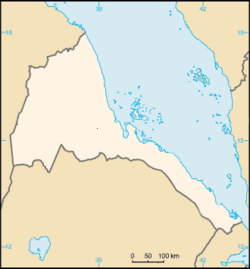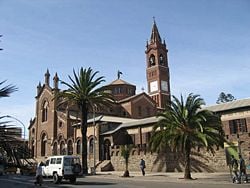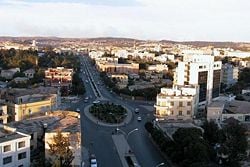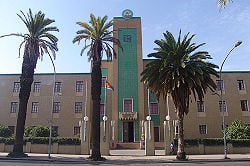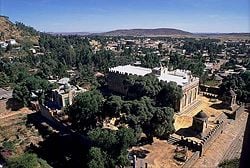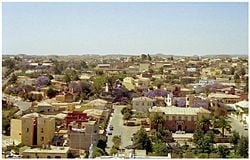Difference between revisions of "Asmara" - New World Encyclopedia
Mike Butler (talk | contribs) |
Mike Butler (talk | contribs) |
||
| Line 160: | Line 160: | ||
In Asmara the main language is Tigrinya. Italian and English are widely spoken and understood. | In Asmara the main language is Tigrinya. Italian and English are widely spoken and understood. | ||
| − | + | Eritrea has two dominant religions (Sunni Islam and Oriental Orthodox Christianity). Asmara is also the [[episcopal see|see]] of the archbishop of the [[Eritrean Orthodox Church]], which became [[autocephalous]] in 1993. The archbishop was elevated in 1998 to the rank of [[Patriarchate]] of Eritrea, on a par with the [[Ethiopian Orthodox Tewahedo Church]]. | |
| − | Asmara is also the [[episcopal see|see]] of the archbishop of the [[Eritrean Orthodox Church]], which became [[autocephalous]] in 1993. The archbishop was elevated in 1998 to the rank of [[Patriarchate]] of Eritrea, on a par with the [[Ethiopian Orthodox Tewahedo Church]]. | ||
The Asmara Synagogue is the only surviving remnant of the once Jewish community in the country of [[Eritrea]]. It includes a Jewish cemetery, classrooms and a main sanctuary. All aspects of the synagogue today are taken care of by Samuel Cohen, an Asmara native who remained in the country to look after it. | The Asmara Synagogue is the only surviving remnant of the once Jewish community in the country of [[Eritrea]]. It includes a Jewish cemetery, classrooms and a main sanctuary. All aspects of the synagogue today are taken care of by Samuel Cohen, an Asmara native who remained in the country to look after it. | ||
Revision as of 22:15, 13 July 2008
| Asmara | |
| Panorama of Asmara | |
| Map of Asmara in Eritrea | |
| Coordinates: 15°20′N 38°56′E | |
|---|---|
| Country | Eritrea |
| Elevation | 7,627 ft (2,325 m) |
| Population (2003) | |
| - Total | 579,000 |
| - Density | 85.2/sq mi (32.9/km²) |
| Time zone | EAT (UTC+3) |
Asmara (English) (Ge'ez: ኣስመራ Asmera, formerly known as Asmera, or in Arabic: أسمرا Asmaraa) is the capital city and largest settlement in Eritrea, home to a population of around 579,000 people. Asmara started with four villages, to being a regional center under Emperor Yohannes IV of Ethiopia, to "Little Rome" of Mussolini's unsuccessful second Roman Empire, to being a provincial capital under Emperor Haile Selassie I of Ethiopia and lastly a national capital of Eritrea.
Geography
At an elevation of over 7627 feet (2325 meters), Asmara is on the edge of an escarpment that is both the northwestern edge of the Great Rift Valley and of the Eritrean highlands.
The highlands are drier and cooler than elsewhere in Eritrea. The January mean temperature is 56.8°F (13.8°C), while the July temperature is 61.3°F (16.3°C). Precipitation averages 1.8 inches (45.72mm) each month, with increased precipitation between late June and early September.
The Gash River rises near Asmara, flows south, turns west and forms the border between Eritrea in the north, and Ethiopia in the south, then flows into northeast Sudan.
The palm-lined main street, which is the location of the Roman Catholic cathedral and the Grand Mosque, is the central focus of the well planned city.
History
Asmara was born out of a union of four villages during the twelfth century. Four clans — Gheza Gurtom, Gheza Shelele, Gheza Serenser and Gheza Asmae — living in the Asmara area on the Kebessa Plateau, united and defeated bandits who preyed on the area. After the victory, the name Arbaete Asmera, which means, in the Tigrinya language, the four united, was adopted. Eventually Arbaete was dropped and it has been called Asmera, though there is still a zone called Arbaete Asmera.
Jesuit priests built a church there around 1621. The missionary Remedius Prutky, who passed through Asmara in 1751, and described in his memoirs that the church was still intact.
Asmara acquired importance in 1881, when Ras Alula Engida, who Emperor Yohannes IV of Ethiopia had appointed governor, founded a market there. In 1884, the emperor moved his capital from Adi Taklay to Asmara, and had three stone buildings built to house his troops and serve as his banquet hall. About the same time Ras Alula ordered all of the other markets in the Mareb Mellash province closed (which included Sazega and Kudofelasi in modern Eritrea as well as Idaga Hamus in Ethiopia), giving further economic stimulus to Asmara. The population grew from an estimated 150 people in 1830 to 2000 during Alula's governorship.
It was occupied by Italy in 1889 and became the national capital in 1897. The city therefore bears many traces of the Italian colonial area: in its infrastructure, its architecture and some culinary traditions. In the early 20th century, a railway line was built to the coast, passing through the town of Ghinda, under the direction of Carlo Cavanna. In both 1913 and 1915 the city suffered only slight damage.
Italian dictator Benito Mussolini's Fascist troops used Asmara as the base for the invasion of Ethiopia in 1935. At this time, Mussolini had great plans for a second Roman Empire in Africa. War cut this short however, but his injection of funds adversely made Asmara what it is today, and was supposedly a symbol that Fascism was working and an ideal system of government.
Most of central Asmara was built between 1935 and 1941, so effectively the Italians managed to build almost an entire city, in just six short years. The Italians changed the face of the town. The city is littered with Italian colonial villas and mansions. Asmara was called Piccola Roma (Little Rome). While Eritrea was under Italian colonial rule, architecturally conservative early-20th-century Europeans used Asmara "to experiment with radical new designs." Nowadays the major part of buildings are of Italian origin, and shops still have Italian names (e.g. Bar Vittoria, Pasticceria moderna, Casa del formaggio, and Ferramenta).
Asmara was governed by the British from 1941 until Eritrea’s federation with Ethiopia in 1952. A United States telecommunications base was sited there from 1942 to 1977.
During the Eritrean war for independence (1961-1991) from Ethiopia, Asmara's airport became a key in the conflict, as it was used by the Ethiopians to obtain arms and supplies from outside supporters. The last town to fall to the Eritrean People's Liberation Front in the Eritrean War of Independence, it was besieged in 1990 and was surrendered by Military of Ethiopia troops without a fight on May 24, 1991.
Asmara became the capital of independent Eritrea in 1993.
Government
Eritrea is a single-party state, run by the People's Front for Democracy and Justice (PFDJ). The National Assembly of 150 seats (of which 75 were occupied by handpicked EPLF guerilla members while the rest went to people sympathetic of the regime), formed in 1993 shortly after independence, "elected" president, Isaias Afewerki. National elections have been periodically scheduled and cancelled; none have ever been held in the country. In 2004, the U.S. State Department declared Eritrea a Country of Particular Concern (CPC) for its alleged record of religious persecution. Eritrea is divided into six regions (zobas) and subdivided into districts — to provide each administration with sufficient control over its agricultural capacity and eliminate historical intra-regional conflicts.
Economy
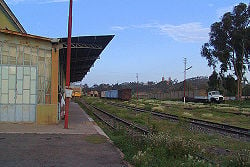
Textiles, clothing, footwear, processed meat, beer, soft drinks, and ceramics are Asmara’s major industrial products. The city is a marketplace for an agricultural products, and a centre for tanning hides.
The Eritrean economy is largely based on agriculture, which employs 80 percent of the population but currently may contribute as little as 12 percent to GDP. Agricultural exports include cotton, fruits and vegetables, hides, and meat, but farmers are largely dependent on rain-fed agriculture, and growth in this and other sectors is hampered by lack of a dependable water supply. Worker remittances and other private transfers from abroad currently contribute about 32 percent of gross domestic product. Per capita GDP for Eritrea was $US800 in 2007.
The ruling party maintains complete control of the economy. The government has imposed arbitrary and complex regulatory requirements that discourage investment from both foreign and domestic sources, and it often reclaims successful private enterprises and property.
There are five major roads that branch out from Asmara. After independence, new major highways were built and old ones renovated. Asmara is served by Asmara International Airport, which has severe capacity restrictions, due to its small terminal, short runway and 1.5 mile altitude. This means that large jet aircraft (like a A380, MD-11 or 747) cannot fly to the airport, and need to use Massawa International Airport, a port city on the Eritrean coast. The Eritrean Railway connects Asmara to Massawa.
Demographics
Population, population rank
Regarding the ethnic makeup of Eritrea, Tigrinya make up 50 percent of the population, Tigre and Kunama 40 percent, Afar 4 percent, Saho (Red Sea coast dwellers) 3 percent, and other 3 percent
In Asmara the main language is Tigrinya. Italian and English are widely spoken and understood.
Eritrea has two dominant religions (Sunni Islam and Oriental Orthodox Christianity). Asmara is also the see of the archbishop of the Eritrean Orthodox Church, which became autocephalous in 1993. The archbishop was elevated in 1998 to the rank of Patriarchate of Eritrea, on a par with the Ethiopian Orthodox Tewahedo Church.
The Asmara Synagogue is the only surviving remnant of the once Jewish community in the country of Eritrea. It includes a Jewish cemetery, classrooms and a main sanctuary. All aspects of the synagogue today are taken care of by Samuel Cohen, an Asmara native who remained in the country to look after it.
Colleges and universities The University of Asmara has more then 2000 day students enrolled in a four-year degree program, and approximately 700 evening students are pursuing two-year extension diploma courses. Founded in 1954 as the Holy Family University Institute, the university has the colleges of science, arts and language studies, business and economics, agriculture and aquatic sciences, as well as engineering, education, and law.
Features
The city is home to the Eritrean National Museum and is known for its early twentieth century buildings, including the Art Deco Cinema Impero, Cubist Africa Pension, eclectic Orthodox Cathedral and former Opera House, the futurist Fiat Tagliero Building, neo-Romanesque Roman Catholic Cathedral, and the neoclassical Governor's Palace.
The city shows off most early 20th century architectural styles; some buildings are neo-Romanesque, such as the Roman Catholic Cathedral, some villas are built in a late Victorian style. Art Deco influences are found throughout the city; essentially Asmara was then what Dubai is now. Architects were restricted by nothing more than the bounds of their imaginations and were given the funds to create masterpieces which we can see today. Essences of Cubism can be found on the Africa Pension Building, and on a small collection of buildings. The Fiat Tagliero Building shows almost the height of futurism, just as it was coming into big fashion in Italy. In recent times, some buildings have been functionally built which sometimes can spoil the atmosphere of some cities, but they fit into Asmara as it is such a modern city.
Asmara is also home to the University of Asmara and a nineteenth century fort, Forte Baldissera.
Asmara was known to be an exceptionally modern city, not only because of its architecture, but Asmara also had more traffic lights than Rome did when the city was being built. [1] The city incorporates many features of a planned city. Indeed, Asmara was an early example of an ideal modern city created by architects, an idea which was introduced into many cities across the world, such as Brasilia, but which was not altogether popular. Features include designated city zoning and planning, wide treed boulevards, political areas and districts and space and scope for development. Asmara was not built for the Eritreans however; the Italians built it primarily for themselves. One unfortunate aspect of the city's planning was areas designated for Italians, and Eritreans, each disproportionately sized.
The city has been regarded as New Rome or Italy's African City due to its quintessential Italian touch, not only for the architecture, but also for the wide streets, piazzas and coffee bars. There are numerable pizzerias and coffee bars, serving cappucinos and lattes, as well as ice cream parlours. The people in Asmara dress in a unique, yet African style. Asmara is also highly praised for its peaceful, crime-free environment. It is one of the cleanest cities of Africa.
The city hosts the We Are the Future center, a child care center giving children a chance to live their childhoods and develop a sense of hope. The center is managed under the direction of the mayor’s office, and the international NGO Glocal Forum serves as the fundraiser and program planner and coordinator for the WAF child center in each city. Each WAF city is linked to several peer cities and public and private partners to create a unique international coalition. Launched in 2004, the program is the result of a strategic partnership between the Glocal Forum, the Quincy Jones Listen Up Foundation and Mr. Hani Masri, with the support of the World Bank, UN agencies and major companies.
Asmara has been proposed as a possible new addition to the UNESCO World Heritage Sites[1], under the direction of the Cultural Assets Rehabilitation Project, for its outstanding examples of 20th century architecture and town planning. Many of these historic buildings are not currently being taken care of and there is a serious risk that this heritage could be lost.
ReferencesISBN links support NWE through referral fees
- Denison, Edward, Guang Yu Ren, and Naigzy Gebremedhin. 2003. Asmara: Africa's secret modernist city. London: Merrell. ISBN 9781858942094
- Prutky, Remedius, J. H. Arrowsmith-Brown, and Richard Pankhurst. 1991. Prutky's travels in Ethiopia and other countries. Works issued by the Hakluyt Society, 2nd ser., no. 174. London: Hakluyt Society. ISBN 9780904180305
- Asmara Asmera.nl, retrieved July 13, 2008.
- Asmara Encyclopaedia Britannica, Retrieved July 13, 2008.
External links
- Ciao Asmara volunteer Justin Hill's book, retrieved July 13, 2008.
- Asmara Eritrea In Pictures, retrieved July 13, 2008.
- Ferrovia eritrea Eritrean Railway, retrieved July 13, 2008.
Credits
New World Encyclopedia writers and editors rewrote and completed the Wikipedia article in accordance with New World Encyclopedia standards. This article abides by terms of the Creative Commons CC-by-sa 3.0 License (CC-by-sa), which may be used and disseminated with proper attribution. Credit is due under the terms of this license that can reference both the New World Encyclopedia contributors and the selfless volunteer contributors of the Wikimedia Foundation. To cite this article click here for a list of acceptable citing formats.The history of earlier contributions by wikipedians is accessible to researchers here:
The history of this article since it was imported to New World Encyclopedia:
Note: Some restrictions may apply to use of individual images which are separately licensed.
- ↑ 1.0 1.1 "Reviving Asmara", BBC 3 Radio, 2005-06-19. Retrieved 2006-08-30. (written in English)
